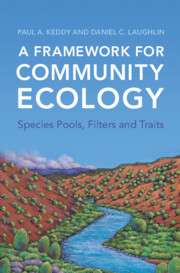Book contents
- A Framework for Community Ecology
- A Framework for Community Ecology
- Copyright page
- Contents
- Preface
- 1 A General Framework for Community Ecology
- 2 Filters
- 3 Species Pools
- 4 Traits
- 5 Trait–Environment Interactions
- 6 Functional Groups
- 7 Predictive Models of Community Assembly
- 8 Prospects and Possibilities
- References
- Index
5 - Trait–Environment Interactions
Published online by Cambridge University Press: 18 November 2021
- A Framework for Community Ecology
- A Framework for Community Ecology
- Copyright page
- Contents
- Preface
- 1 A General Framework for Community Ecology
- 2 Filters
- 3 Species Pools
- 4 Traits
- 5 Trait–Environment Interactions
- 6 Functional Groups
- 7 Predictive Models of Community Assembly
- 8 Prospects and Possibilities
- References
- Index
Summary
In order to assemble an ecological community it may be helpful to know not only how many parts there are, but what kinds of parts there are. Communities require at least two classification systems that provide simultaneous and somewhat contradictory lists of parts: phylogenetic and functional. These two classification systems can be arranged hierarchically so that many parts (species) are nested within a smaller number of groups (functional types). Even with objective classification techniques, it is difficult to know how many groups exist, and the number selected may be somewhat arbitrary. There does not seem to be a way to tell, a priori, how many functional types we can expect to find in a specified landscape or habitat. This raises difficult questions about the nature of fitness landscapes and the geometry of n-dimensional trait space.
Keywords
- Type
- Chapter
- Information
- A Framework for Community EcologySpecies Pools, Filters and Traits, pp. 165 - 189Publisher: Cambridge University PressPrint publication year: 2021

